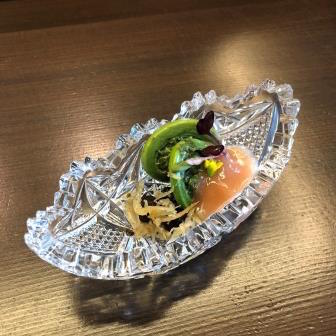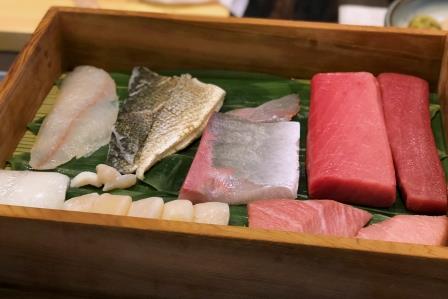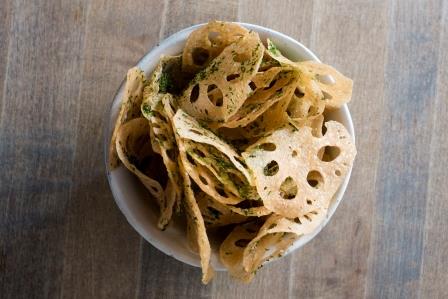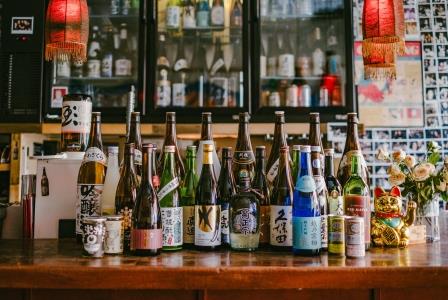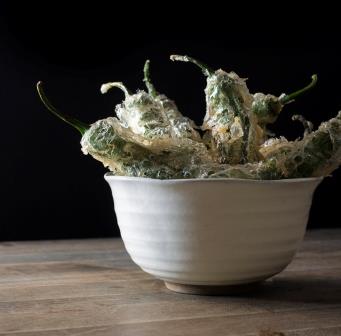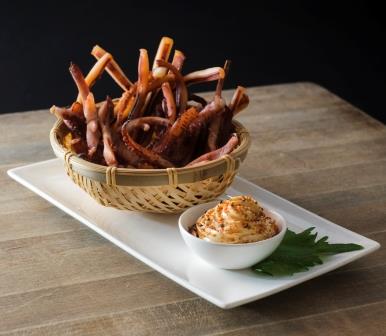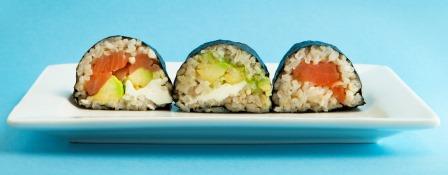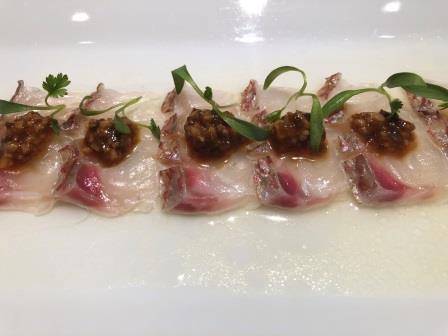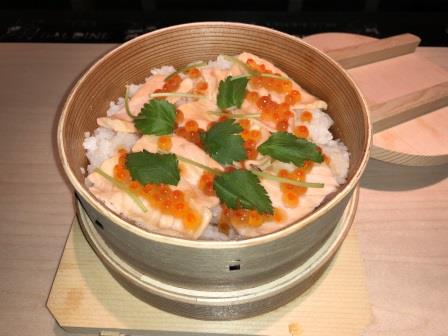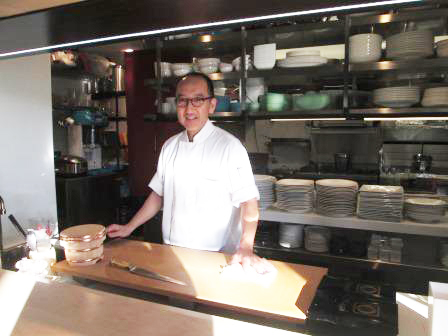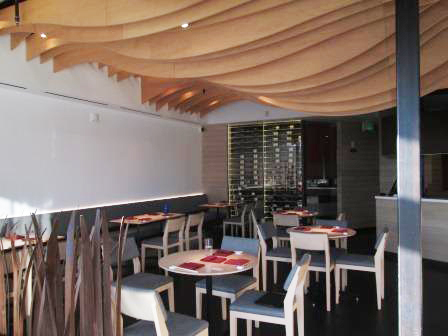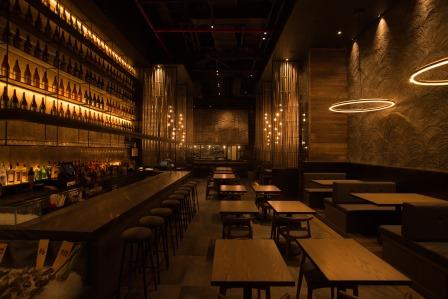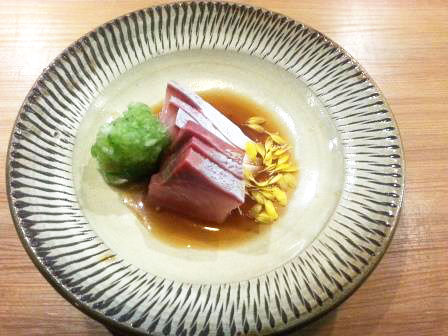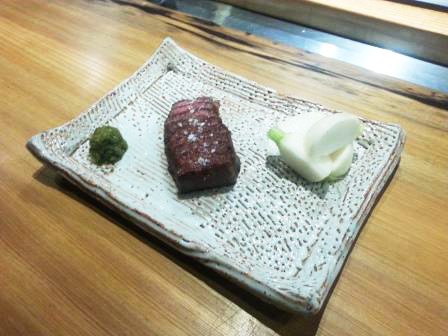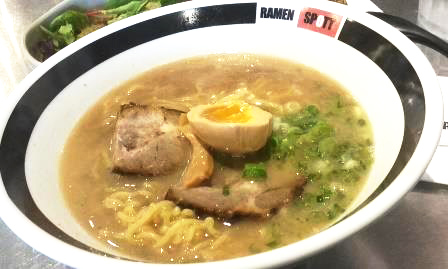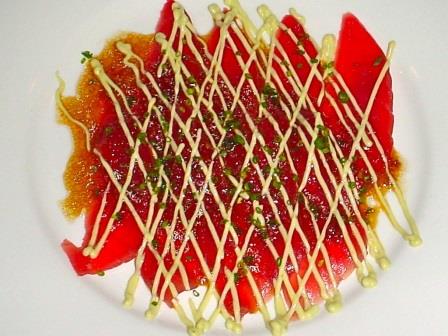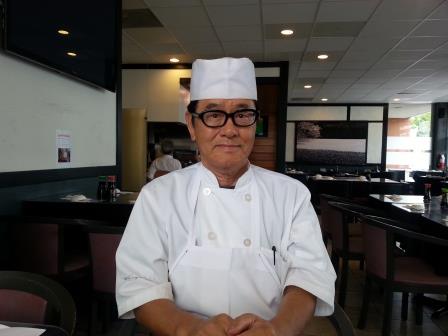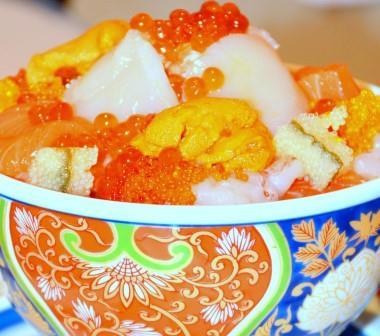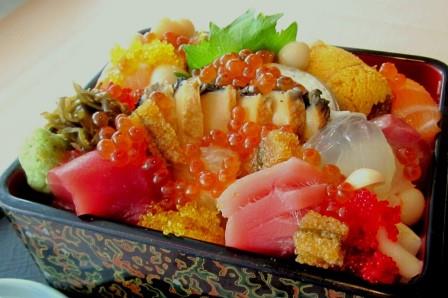Authentic sushi by Tsukiji-acquired skills enjoyed in a hideout with limited seating of 7
By Elli Sekine
“Yume Sushi”, a famous popular sushi restaurant located in the Alameda District, which is on the east side of the bay across the Bay Bridge of San Francisco, closed its doors last fall and is still being missed by many people. Yume’s owner entrusted the next phase of his dream to Chikara Ono, who now runs some hot restaurants in the East Bay such as Delage and As B-Dama, which are really on a roll. The restaurant which opened only less than half a year after the closing of Yume Sushi is “Utzutzu”, which offers new concept kaiseki cuisine. Their menu uses the word, “Okimari”, instead of “Omakase”, which exhibits the strong will of this young manager. “Utzutzu (reality in Japanese)” that succeeded “Yume (dream in Japanese)” has been filled up with customers every day despite the fact that they opened only a short time ago.
The restaurant is located on a major street, but no sigh is displayed on the street, and you need to go upstairs to enter, which gives this place a hideout-like ambience. The interior decoration has a combined theme of antique Taisho-era romantic and Showa-era modern. By removing the wall to the next room which was an office space, the sushi counter was made, and a cool royal blue- colored couch was added to create a lounge. They take only 5:30 and 8:30 reservations, and the two reservations do not overlap. Customers are to wait in the lounge, enjoying drinks until everybody in the party arrives. The drink menu contains 2 to 3 kinds of each Daiginjo, Ginjo, and Junmai sake brands, plus beer is domestic beer and two kinds of Japanese craft beer. Nicely cooled sake is served in an antique glass. The chef who serves sushi at the counter is Joji Nonaka, who has experience working at Tsukiji selling wholesale fresh seafood, and at Ichi Sushi, a popular sushi restaurant in San Francisco. He determines the contents of the menu with Chef Asuka Uchida, who is in charge of other items besides sushi.
Nonaka was making sushi side by side with Ono behind the counter of Delage, long before the opening of Utzutzu came up. Ono then decided to entrust Utzutzu to Nonaka by witnessing Ono always offering customers sushi at the best possible condition. As for Chef Uchida, she has a background of working at French restaurants, and has worked in Japan, Australia, and New York before.
Chef Uchida has worked under Ono for nearly 5 years since the B- Dama days, and her keen sense in cooking is highly trusted.
There is only one menu item, which is the $100 Okimari course. The course consists of 15 to 16 pieces of sushi, and seasonal vegetable dishes are served in-between while sushi is served. To finalize the course, temaki (hand-rolled) sushi, and miso soup, and a dessert are served. In America, a course with pre-fixed price and menu can be called “Omakase”; however in Japan, it is called “Okimari”. “Omakase” in Japan, on the other hand, means neither the price nor the contents of the course is pre-fixed. It is an ultimate choice, in which the crafty chef makes sushi, etc., depending on the customer’s preference, and serves whatever the good ingredients they have for the day.
Nonaka says that he would also like to offer an “Omakase” menu in the future. At Utzutzu, they are particular about serving authentic Japanese style sushi. The fish is directly shipped mainly from Tsukiji and Kyushu, and for nigiri, they are particular about bringing out each fish’s natural flavor, rather than accentuating the taste with unique sauces or toppings. Depending on the ingredients, some preparation is involved such as light-salting or konbu-jime (kelp-sandwiching), but it is done to remove excess water or unwanted taste rather than accentuating the taste of the ingredient.
During my visit, black porgy konbu-jime was served first, followed by fire-grilled skin of the same fish. Excess water was removed from the tender meat by konbu-jime treatment, and the fish was light-tasting, but was full of umami.
Fatty skin adds flavor, and its texture becomes so tender, which melts in your mouth. The same fish can be enjoyed in totally different ways depending on the parts. The course always includes about 2 pieces of vegetable sushi. It is because they want the course to have variations with a seasonal flare that is uniquely California.
Different blends of soy sauces are used to accentuate light-tasting ingredients and rich-tasting ingredients. Another example of particularity they exhibit is that raw wasabi directly shipped from Japan is grated in front of customers.
Rich-colored vinegared rice is made with mildly sweet red vinegar. Nonaka says that he would like to keep the old sushi traditions, but at the same time, bring any good things in to grow further. He is assertive about taking any interesting ingredients in. For example, a vegetable called seabean, which grows by the sea is combined with fatty tuna for the course’s last item, a hand-roll, taking advantage of its natural saltiness and crunchy texture. It’s the Nonaka version of the standard hand-roll, “Toro-Taku”, arranged his way.
For the dishes other than sushi, they use vegetables procured from the local farmer’s markets, which are cooked in robust flavor, which also matches Japanese sake well.
French cuisine-influenced good sense is shown in the techniques and presentations by the chef of that background. For instance, the base of octopus in vinegar sauce has certainly a Japanese dashi-based taste, but it is presented so gorgeously in a cocktail glass, which looks like a modern French dish. Their desserts also taste so good, and are beyond the level of a sushi place, and their beautiful appearance will surely satisfy customers.
This restaurant is full of customers every day. Foodies come from not only the local Alameda District, but also San Francisco, and fill this restaurant. While the high-end Omakase sushi boom seems to have settled, there are more customers now, who understand sushi culture well, and this must be the reason for the popularity of this place.
Both Chef Nonaka and Chef Uchida hope to evolve the Japan-like sushi style further, while conveying it to American people. I would like to keep close eyes on Utzutzu’s future development.
限定7席の隠れ家で味わう築地仕込みの本格寿司
サンフランシスコからベイブリッジを渡った東側の湾、アラメダ地区に寿司の名店として人気を博していた「Yume Sushi」が昨年秋、周囲に惜しまれつつ閉店した。Yumeのオーナーがその夢の続きを託した人物が、今イーストベイでノリに乗っている人気店、DelageやAs B-damaの経営者である小野力氏だ。クローズからたった半年余りでオープンしたのが、新しいコンセプトの寿司懐石を提案する「Utzutzu」だ。メニューには「おまかせ」ならぬ「おきまり」と明記し、若き経営者の本気度を感じさせられる。「夢 Yume」の後を引き継いた「現(うつつ) Utzutzu」はまだ開店したばかりにも関わらず連日満席の人気ぶりだ。
店はメインストリートに位置するが、看板もなく階段を上がった二階にある隠れ家的存在だ。内装は大正ロマン/昭和モダンを取り入れたアンティークなイメージで統一されている。元事務所スペースとの壁を取り壊し、寿司カウンターに加え、鮮やかなロイヤルブルーのソファーを配したラウンジを作った。予約は5時半と8時半の完全入れ替え制。客は全員が揃うのを待つ間、このラウンジでドリンクを楽しむ。ドリンクは日本酒が大吟醸、吟醸、純米酒が2〜3種ずつ、ビールはローカルと日本のクラフトビール2種。適温に冷やされた酒はアンティークのグラスで提供される。カウンターで寿司を握るのは、築地での鮮魚卸やサンフランシスコの人気寿司店ICHI Sushiでの経験もある野中城治シェフ。メニュー内容は寿司以外の料理を担当する内田明日香シェフと相談して決めている。野中氏はUtzutzu開店の話が出る以前からDelageで小野氏と並びカウンターで寿司を握っていた。小野氏は常に最高の状態で客に寿司を提供しようとする野中氏を見て、Utzutzuを任せようと決めたという。一方の内田シェフはフレンチレストラン出身で、日本、オーストラリア、ニューヨークでの経験を経て現在がある。小野氏の元ではB-dama時代から5年近く仕事をし、その料理センスには全幅の信頼がある。
メニューは$100のおきまり1コースのみ。寿司が15〜16貫、合間にキッチンからの季節の野菜料理があり、しめの手巻きすしと味噌汁、デザートと続く。アメリカでは価格とメニューの決まったコースは「おまかせ」で通るが、日本ではこのスタイルは「おきまり」と呼ばれる。一方の「おまかせ」は価格もメニュー内容も決まりはなく、職人は客の好みやその日の良いネタからそれぞれの客に合わせて寿司を出す究極のセレクションだ。野中氏は将来的に「おまかせ」も提供して行きたいと語る。Utzutzuでのこだわりは日本的な寿司。魚は主に築地や九州からの直送で、握りには変わりソースやトッピングで味を乗せるのではなく、魚の味を引き出すことにこだわる。ネタによっては軽く塩や昆布で〆るなどの手をかけるが、これは味をのせるためというよりも、余分な水分や雑味を取り除くための仕事だ。訪店時には最初に黒鯛の昆布締めが出され、続いて黒鯛の皮の部分の炙りをいただいた。淡白で柔らかい身は昆布で締めることで余分な水分が抜け、さっぱりとしつつ旨味が広がる。脂ののった皮には香ばしさが加わりとろける口当たりになる。同じ魚でも部位で全く違う味わいを楽しめる。握りの中には必ず2貫程度野菜の握りもある。カリフォルニアならではの季節感を出し、コースに変化を持たせるためだ。淡白なネタと味の濃いネタでは仕上げ醤油の配合も変えている。日本から直送の生ワサビを客の前でおろして使うのもこだわりだ。
濃い色の酢飯はまろやかな甘みのある赤酢(粕酢)を使用している。野中氏は寿司の伝統にもこだわりつつ、良いものは取り入れ成長して行きたいと語る。食材でも面白いものがあれば積極的にとり入れる。例えばシービーンズという海岸で育つ野菜は天然の塩気とシャキシャキとした食感を生かし、最後の手巻きでトロと合わせる。手巻きの定番、「トロタク」を野中流にアレンジした形だ。
寿司以外の料理は地元のファーマーズマーケットなどから仕入れた野菜を使い、日本酒にも合うしっかりとした味付けになっている。テクニックや盛り付けにはフレンチ出身シェフならではセンスも生かされている。例えば蛸の酢の物のベースはしっかりと和の出汁の聞いた味わいだが、カクテルグラスへの盛り付けはモダンフレンチを思わせる華やかさだ。デザートも寿司屋の域を超えたパティスリーレベルの美味しさ、美しさで客を満足させる。
店はすでに連日フルハウス。地元アラメダのみならず、サンフランシスコからのフーディーな客でいっぱいだ。ハイエンドおまかせ寿司ブームは一段落したとはいえ、数年前よりも寿司に理解のある客が増えたからこその人気ではないだろうか。より日本らしい寿司スタイルをアメリカ人にも伝えつつ進化させたいとする野中氏と内田氏。Utzutzuの展開をこれからも注視していきたい。
Utzutzu
1428 Park St, Alameda, CA 94501
Tel: (510) 263-8122
Business Hours Tue-Sun 5:30-,8:30 - (replacement system)
Monday closed
Reservation: Through Resy
“Yume Sushi”, a famous popular sushi restaurant located in the Alameda District, which is on the east side of the bay across the Bay Bridge of San Francisco, closed its doors last fall and is still being missed by many people. Yume’s owner entrusted the next phase of his dream to Chikara Ono, who now runs some hot restaurants in the East Bay such as Delage and As B-Dama, which are really on a roll. The restaurant which opened only less than half a year after the closing of Yume Sushi is “Utzutzu”, which offers new concept kaiseki cuisine. Their menu uses the word, “Okimari”, instead of “Omakase”, which exhibits the strong will of this young manager. “Utzutzu (reality in Japanese)” that succeeded “Yume (dream in Japanese)” has been filled up with customers every day despite the fact that they opened only a short time ago.
The restaurant is located on a major street, but no sigh is displayed on the street, and you need to go upstairs to enter, which gives this place a hideout-like ambience. The interior decoration has a combined theme of antique Taisho-era romantic and Showa-era modern. By removing the wall to the next room which was an office space, the sushi counter was made, and a cool royal blue- colored couch was added to create a lounge. They take only 5:30 and 8:30 reservations, and the two reservations do not overlap. Customers are to wait in the lounge, enjoying drinks until everybody in the party arrives. The drink menu contains 2 to 3 kinds of each Daiginjo, Ginjo, and Junmai sake brands, plus beer is domestic beer and two kinds of Japanese craft beer. Nicely cooled sake is served in an antique glass. The chef who serves sushi at the counter is Joji Nonaka, who has experience working at Tsukiji selling wholesale fresh seafood, and at Ichi Sushi, a popular sushi restaurant in San Francisco. He determines the contents of the menu with Chef Asuka Uchida, who is in charge of other items besides sushi.
Nonaka was making sushi side by side with Ono behind the counter of Delage, long before the opening of Utzutzu came up. Ono then decided to entrust Utzutzu to Nonaka by witnessing Ono always offering customers sushi at the best possible condition. As for Chef Uchida, she has a background of working at French restaurants, and has worked in Japan, Australia, and New York before.
Chef Uchida has worked under Ono for nearly 5 years since the B- Dama days, and her keen sense in cooking is highly trusted.
There is only one menu item, which is the $100 Okimari course. The course consists of 15 to 16 pieces of sushi, and seasonal vegetable dishes are served in-between while sushi is served. To finalize the course, temaki (hand-rolled) sushi, and miso soup, and a dessert are served. In America, a course with pre-fixed price and menu can be called “Omakase”; however in Japan, it is called “Okimari”. “Omakase” in Japan, on the other hand, means neither the price nor the contents of the course is pre-fixed. It is an ultimate choice, in which the crafty chef makes sushi, etc., depending on the customer’s preference, and serves whatever the good ingredients they have for the day.
Nonaka says that he would also like to offer an “Omakase” menu in the future. At Utzutzu, they are particular about serving authentic Japanese style sushi. The fish is directly shipped mainly from Tsukiji and Kyushu, and for nigiri, they are particular about bringing out each fish’s natural flavor, rather than accentuating the taste with unique sauces or toppings. Depending on the ingredients, some preparation is involved such as light-salting or konbu-jime (kelp-sandwiching), but it is done to remove excess water or unwanted taste rather than accentuating the taste of the ingredient.
During my visit, black porgy konbu-jime was served first, followed by fire-grilled skin of the same fish. Excess water was removed from the tender meat by konbu-jime treatment, and the fish was light-tasting, but was full of umami.
Fatty skin adds flavor, and its texture becomes so tender, which melts in your mouth. The same fish can be enjoyed in totally different ways depending on the parts. The course always includes about 2 pieces of vegetable sushi. It is because they want the course to have variations with a seasonal flare that is uniquely California.
Different blends of soy sauces are used to accentuate light-tasting ingredients and rich-tasting ingredients. Another example of particularity they exhibit is that raw wasabi directly shipped from Japan is grated in front of customers.
Rich-colored vinegared rice is made with mildly sweet red vinegar. Nonaka says that he would like to keep the old sushi traditions, but at the same time, bring any good things in to grow further. He is assertive about taking any interesting ingredients in. For example, a vegetable called seabean, which grows by the sea is combined with fatty tuna for the course’s last item, a hand-roll, taking advantage of its natural saltiness and crunchy texture. It’s the Nonaka version of the standard hand-roll, “Toro-Taku”, arranged his way.
For the dishes other than sushi, they use vegetables procured from the local farmer’s markets, which are cooked in robust flavor, which also matches Japanese sake well.
French cuisine-influenced good sense is shown in the techniques and presentations by the chef of that background. For instance, the base of octopus in vinegar sauce has certainly a Japanese dashi-based taste, but it is presented so gorgeously in a cocktail glass, which looks like a modern French dish. Their desserts also taste so good, and are beyond the level of a sushi place, and their beautiful appearance will surely satisfy customers.
This restaurant is full of customers every day. Foodies come from not only the local Alameda District, but also San Francisco, and fill this restaurant. While the high-end Omakase sushi boom seems to have settled, there are more customers now, who understand sushi culture well, and this must be the reason for the popularity of this place.
Both Chef Nonaka and Chef Uchida hope to evolve the Japan-like sushi style further, while conveying it to American people. I would like to keep close eyes on Utzutzu’s future development.
限定7席の隠れ家で味わう築地仕込みの本格寿司
サンフランシスコからベイブリッジを渡った東側の湾、アラメダ地区に寿司の名店として人気を博していた「Yume Sushi」が昨年秋、周囲に惜しまれつつ閉店した。Yumeのオーナーがその夢の続きを託した人物が、今イーストベイでノリに乗っている人気店、DelageやAs B-damaの経営者である小野力氏だ。クローズからたった半年余りでオープンしたのが、新しいコンセプトの寿司懐石を提案する「Utzutzu」だ。メニューには「おまかせ」ならぬ「おきまり」と明記し、若き経営者の本気度を感じさせられる。「夢 Yume」の後を引き継いた「現(うつつ) Utzutzu」はまだ開店したばかりにも関わらず連日満席の人気ぶりだ。
店はメインストリートに位置するが、看板もなく階段を上がった二階にある隠れ家的存在だ。内装は大正ロマン/昭和モダンを取り入れたアンティークなイメージで統一されている。元事務所スペースとの壁を取り壊し、寿司カウンターに加え、鮮やかなロイヤルブルーのソファーを配したラウンジを作った。予約は5時半と8時半の完全入れ替え制。客は全員が揃うのを待つ間、このラウンジでドリンクを楽しむ。ドリンクは日本酒が大吟醸、吟醸、純米酒が2〜3種ずつ、ビールはローカルと日本のクラフトビール2種。適温に冷やされた酒はアンティークのグラスで提供される。カウンターで寿司を握るのは、築地での鮮魚卸やサンフランシスコの人気寿司店ICHI Sushiでの経験もある野中城治シェフ。メニュー内容は寿司以外の料理を担当する内田明日香シェフと相談して決めている。野中氏はUtzutzu開店の話が出る以前からDelageで小野氏と並びカウンターで寿司を握っていた。小野氏は常に最高の状態で客に寿司を提供しようとする野中氏を見て、Utzutzuを任せようと決めたという。一方の内田シェフはフレンチレストラン出身で、日本、オーストラリア、ニューヨークでの経験を経て現在がある。小野氏の元ではB-dama時代から5年近く仕事をし、その料理センスには全幅の信頼がある。
メニューは$100のおきまり1コースのみ。寿司が15〜16貫、合間にキッチンからの季節の野菜料理があり、しめの手巻きすしと味噌汁、デザートと続く。アメリカでは価格とメニューの決まったコースは「おまかせ」で通るが、日本ではこのスタイルは「おきまり」と呼ばれる。一方の「おまかせ」は価格もメニュー内容も決まりはなく、職人は客の好みやその日の良いネタからそれぞれの客に合わせて寿司を出す究極のセレクションだ。野中氏は将来的に「おまかせ」も提供して行きたいと語る。Utzutzuでのこだわりは日本的な寿司。魚は主に築地や九州からの直送で、握りには変わりソースやトッピングで味を乗せるのではなく、魚の味を引き出すことにこだわる。ネタによっては軽く塩や昆布で〆るなどの手をかけるが、これは味をのせるためというよりも、余分な水分や雑味を取り除くための仕事だ。訪店時には最初に黒鯛の昆布締めが出され、続いて黒鯛の皮の部分の炙りをいただいた。淡白で柔らかい身は昆布で締めることで余分な水分が抜け、さっぱりとしつつ旨味が広がる。脂ののった皮には香ばしさが加わりとろける口当たりになる。同じ魚でも部位で全く違う味わいを楽しめる。握りの中には必ず2貫程度野菜の握りもある。カリフォルニアならではの季節感を出し、コースに変化を持たせるためだ。淡白なネタと味の濃いネタでは仕上げ醤油の配合も変えている。日本から直送の生ワサビを客の前でおろして使うのもこだわりだ。
濃い色の酢飯はまろやかな甘みのある赤酢(粕酢)を使用している。野中氏は寿司の伝統にもこだわりつつ、良いものは取り入れ成長して行きたいと語る。食材でも面白いものがあれば積極的にとり入れる。例えばシービーンズという海岸で育つ野菜は天然の塩気とシャキシャキとした食感を生かし、最後の手巻きでトロと合わせる。手巻きの定番、「トロタク」を野中流にアレンジした形だ。
寿司以外の料理は地元のファーマーズマーケットなどから仕入れた野菜を使い、日本酒にも合うしっかりとした味付けになっている。テクニックや盛り付けにはフレンチ出身シェフならではセンスも生かされている。例えば蛸の酢の物のベースはしっかりと和の出汁の聞いた味わいだが、カクテルグラスへの盛り付けはモダンフレンチを思わせる華やかさだ。デザートも寿司屋の域を超えたパティスリーレベルの美味しさ、美しさで客を満足させる。
店はすでに連日フルハウス。地元アラメダのみならず、サンフランシスコからのフーディーな客でいっぱいだ。ハイエンドおまかせ寿司ブームは一段落したとはいえ、数年前よりも寿司に理解のある客が増えたからこその人気ではないだろうか。より日本らしい寿司スタイルをアメリカ人にも伝えつつ進化させたいとする野中氏と内田氏。Utzutzuの展開をこれからも注視していきたい。
Utzutzu
1428 Park St, Alameda, CA 94501
Tel: (510) 263-8122
Business Hours Tue-Sun 5:30-,8:30 - (replacement system)
Monday closed
Reservation: Through Resy






